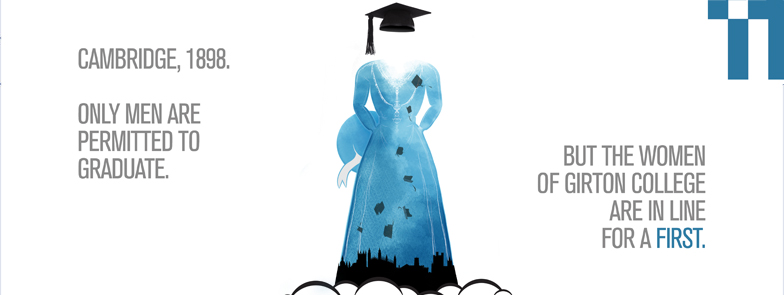Who’s Who in Vita and Virginia
Virginia Woolf
Virginia Woolf was one of the foremost literary figures of the 20th century. Her most famous works include the novels Mrs Dalloway, Orlando and To The Lighthouse.
Throughout her life, she was plagued by recurring mental illness. Her first breakdown occurred after the deaths of her mother and half-sister in her early teens, followed by an even more acute episode after the death of her father, which led to her being briefly institutionalised. Throughout the remainder of her life, the illness periodically returned – frequently following significant life events, such as the deaths of loved ones, or the publications of her works. However, despite this, she was a prolific writer, publishing her first novel in 1915 and continuing to work until her death. Her novels were innovative – she experimented with stream-of-consciousness narrative and with different approaches to biographical storytelling, and delved into the underlying psychological motives of her characters. Her works have been translated into over 50 languages.
After completing the manuscript of her last (posthumously published) novel, Between the Acts, she fell ill once more. She began hearing voices again, and was unable to concentrate or work. Unable to bear the idea of another collapse, on 28th March 1941, she put on her overcoat, filled its pockets with stones, and walked into the river near her home and drowned herself.
Vita Sackville-West
The Hon Victoria Mary Sackville-West, Lady Nicolson, better known as Vita Sackville-West, was an author, poet and gardener. She is best remembered for the beautiful gardens which she and her husband Harold Nicholson created at Sissinghurst Castle, but was also notorious for her exuberant lifestyle, and for her unconventional balancing of a strong marriage with a plethora of affairs with other women.
Vita’s affairs were often tempestuous – her relationship with Violet Trefusis in particular involved elopements to France, pursuit by husbands, raging rows and desperate streams of letters. However, this never interfered with the closeness between Vita and Harold (who himself also had same-sex affairs). They exchanged almost daily letters when separated, had two sons, and travelled across the world together following Harold’s diplomatic postings.
Her best-known novels today are The Edwardians and All Passion Spent; however, she also wrote poems (winning the Hawthornden Prize in 1927 for her poem The Land) and biographies. In 1947, she was made a Companion of Honour for her services to literature. The following year she became a founder member of the National Trust’s garden committee, the organisation which today owns and maintains the gardens she created at Sissinghurst.
Other characters
Vanessa Bell (Nessa): Virginia’s Woolf’s sister; a painter, interior designer and member of the Bloomsbury group.
Julian Bell: Vanessa’s son, Virginia Woolf’s nephew.
Bloomsbury Group: an influential group of writers, intellectuals, philosophers and artists working during the first half of the 20th century. The Bloomsbury group were primarily liberal in politics, and reacted against what they saw as the conventions of Victorian life, favouring a more informal focus upon personal relationships and individual pleasure.  Its members included the Woolfs, Lytton Strachey, Maynard Keynes, E. M. Forster and others.
Mary Campbell: the eldest of seven sisters known for their many love affairs with famous artists, writers and musicians of interwar London. She was a member of the Bloomsbury Group and the wife of the radical South African poet Roy Campbell, who was incensed by his wife’s affair with Vita.
Tom (T.S.) Eliot: an American playwright, literary critic and poet.
Duncan Grant: a painter and designer of textiles, pottery and theatre sets. Despite having always been gay, he formed a relationship with Virginia’s sister Vanessa which would last until her death over 40 years later.
Hogarth Press: a printing house founded by Leonard and Virginia Woolf in 1917 – it grew from a single hand-operated printing press to a full-scale publishing house.
Hilda Matheson: the head of the BBC Talks Department, with whom Vita had an affair between 1929 and 1931.
Harold Nicholson: Vita Sackville-West’s husband; a diplomat, author and politician.
Edith Sitwell: an aristocratic poet and critic of eccentric appearance.
Lytton Strachey: a writer, critic and founding member of the Bloomsbury group. He was open about his homosexuality amongst the Bloomsbury group, having an affair with Maynard Keynes amongst others, but it was only revealed publicly long after his death.
Violet Trefusis: an English writer and socialite who had a turbulent affair with Vita Sackville-West.
Dorothy Wellesley, Duchess of Wellington (Dottie): a socialite, author, poet and literary editor with whom Vita Sackville-West had an affair – Wellesley reportedly abandoned her husband and children for Vita. She subsequently had a relationship with Hilda Matheson, which lasted until Hilda’s death.
Leonard Woolf: Virginia Woolf’s husband; an author, publisher and civil servant.
Cate Field

